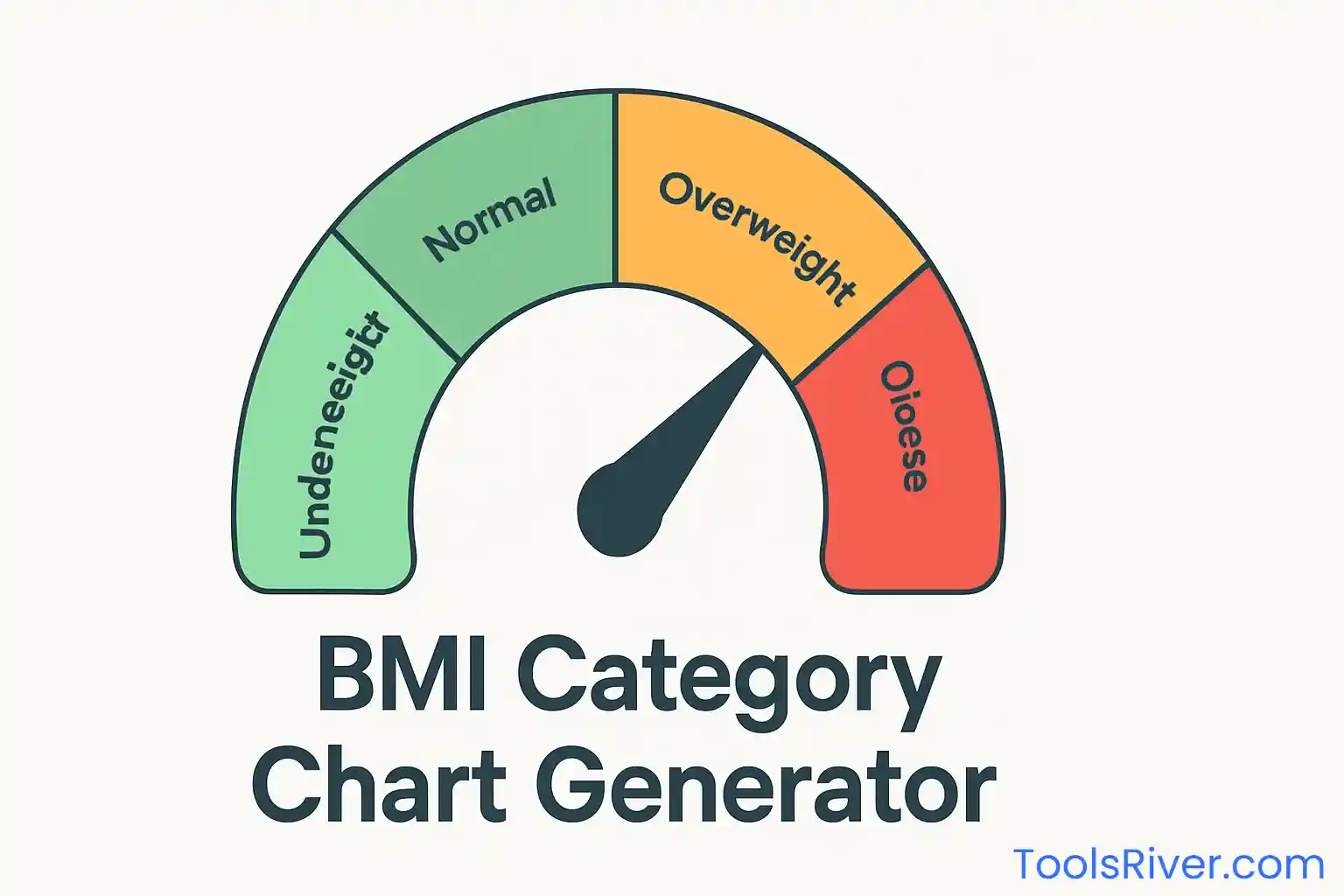BMI Category Chart Generator
Create personalized BMI charts, assess health risks, and get comprehensive insights into your body mass index with our advanced calculator and visualization tools.
BMI Calculator
BMI Categories
May indicate malnutrition or health issues
Indicates healthy weight range
Increased risk of health problems
Significantly increased health risks
BMI is a screening tool and doesn't directly measure body fat. Consult healthcare professionals for comprehensive health assessment.
Your BMI Results & Chart
Your BMI
BMI Category Chart
Detailed Health Analysis
Understanding BMI and Health Assessment
What is BMI?
Body Mass Index (BMI) is a numerical value derived from an individual's weight and height. It serves as a screening tool to categorize individuals into different weight status categories and assess potential health risks associated with weight. BMI is calculated using the formula: weight (kg) / height (m)². While BMI doesn't directly measure body fat, it provides a useful population-level indicator for identifying potential weight-related health issues.
BMI Categories Explained
The World Health Organization defines four main BMI categories: Underweight (BMI < 18.5), Normal weight (BMI 18.5-24.9), Overweight (BMI 25.0-29.9), and Obese (BMI ≥ 30.0). Each category is associated with different health risk levels. Normal weight typically indicates the lowest risk for weight-related health problems, while underweight and overweight categories may indicate increased health risks requiring medical attention or lifestyle modifications.
Health Implications of Different BMI Ranges
Underweight (BMI < 18.5)
Being underweight may indicate malnutrition, eating disorders, or underlying health conditions. Risks include weakened immune system, osteoporosis, anemia, and fertility problems. Individuals in this category should consult healthcare providers to identify underlying causes and develop appropriate weight gain strategies through proper nutrition and medical guidance.
Normal Weight (BMI 18.5-24.9)
This range is associated with the lowest risk of weight-related health problems. Individuals in this category typically have optimal health outcomes and should focus on maintaining their current weight through balanced nutrition, regular physical activity, and healthy lifestyle choices. Regular monitoring helps ensure continued health maintenance.
Overweight (BMI 25.0-29.9)
Overweight individuals face increased risks for type 2 diabetes, high blood pressure, heart disease, and certain cancers. However, this category also presents an opportunity for prevention through lifestyle modifications. Weight loss of 5-10% of body weight can significantly reduce health risks and improve overall well-being.
Obese (BMI ≥ 30.0)
Obesity significantly increases the risk of serious health conditions including heart disease, stroke, type 2 diabetes, sleep apnea, and certain types of cancer. Class I (BMI 30-34.9), Class II (BMI 35-39.9), and Class III (BMI ≥ 40) obesity carry progressively higher health risks. Medical intervention and comprehensive lifestyle changes are typically recommended.
How to Use Our BMI Chart Generator
Step-by-Step Guide:
- Enter your height using the preferred unit (centimeters, feet, or meters)
- Input your current weight in kilograms or pounds
- Optionally provide age and gender for enhanced analysis
- Click "Calculate BMI & Generate Chart" to process your data
- Review your BMI value, category, and health risk assessment
- Examine the visual chart showing your position within BMI categories
- Read the detailed health analysis and recommendations
- Use the copy function to save your results for future reference
Key Features:
- Multiple unit support for international users
- Interactive visual charts for better understanding
- Personalized health risk assessment
- Age and gender-specific analysis when provided
- Comprehensive educational content
- Mobile-responsive design for all devices
- Instant results with professional presentation
- Copy-to-clipboard functionality for easy sharing
Important Limitations and Considerations
While BMI is a valuable screening tool, it has important limitations that users should understand. BMI doesn't differentiate between muscle mass and fat mass, which means that muscular individuals like athletes may be classified as overweight or obese despite having low body fat percentages. Similarly, older adults may fall within the normal BMI range while having higher body fat percentages due to age-related muscle loss.
BMI calculations may also vary in accuracy across different ethnic groups. Some populations may have different health risk profiles at the same BMI levels. For instance, people of Asian descent may face increased health risks at lower BMI values compared to other populations. Therefore, BMI should always be considered alongside other health indicators and professional medical assessment.
Additional factors that BMI doesn't account for include bone density, overall body composition, muscle distribution, and individual health history. For comprehensive health assessment, consider consulting healthcare professionals who can evaluate multiple factors including waist circumference, body fat percentage, blood pressure, cholesterol levels, and other relevant health markers.
Medical Disclaimer: This BMI calculator is for informational purposes only and should not replace professional medical advice. Always consult with qualified healthcare providers for personalized health assessment and treatment recommendations.
Frequently Asked Questions
BMI is a useful screening tool but has limitations. It provides a general indication of whether someone is at a healthy weight, but it doesn't account for muscle mass, bone density, or fat distribution. For athletes or very muscular individuals, BMI may overestimate body fat. For older adults, it may underestimate body fat. BMI should be used in conjunction with other health indicators and professional medical assessment for accurate health evaluation.
If your BMI indicates overweight or obesity, consult with a healthcare provider for personalized advice. They can assess your overall health, discuss risk factors, and recommend appropriate interventions. Generally, gradual weight loss through balanced nutrition and regular physical activity is recommended. Even a 5-10% reduction in body weight can significantly improve health outcomes. Avoid extreme diets and focus on sustainable lifestyle changes.
The BMI calculation formula is the same for both men and women: weight (kg) divided by height (m) squared. However, the health implications may differ slightly between genders. Women typically have higher body fat percentages than men at the same BMI due to biological differences. Some research suggests that gender-specific BMI interpretation may be more accurate, but the standard categories are widely used for both sexes.
For adults (18+ years), standard BMI categories apply. For children and adolescents (2-19 years), BMI is calculated the same way but interpreted using age and gender-specific percentile charts rather than fixed categories. BMI monitoring typically begins around age 2. Children's BMI changes significantly as they grow, so tracking BMI percentiles over time is more meaningful than individual measurements.
For general health monitoring, calculating BMI monthly or quarterly is sufficient. If you're actively trying to lose or gain weight, weekly or bi-weekly measurements can help track progress. However, focus on long-term trends rather than daily fluctuations. Weight can vary due to factors like hydration, meal timing, and hormonal changes. Consistent measurement conditions (same time of day, same clothing) improve accuracy.











